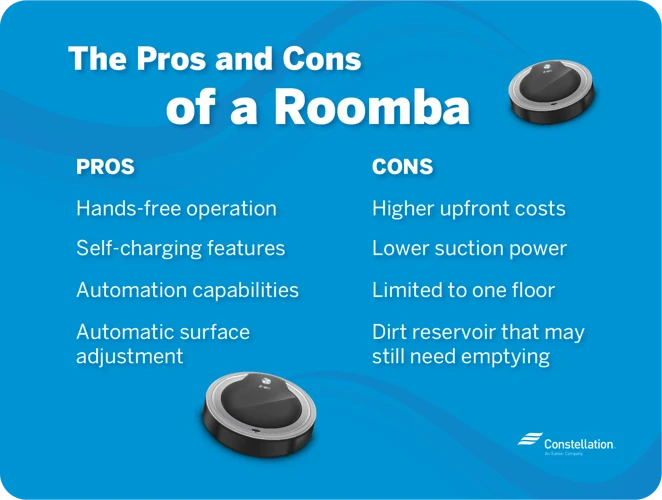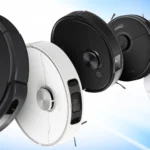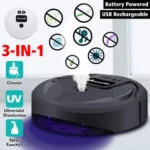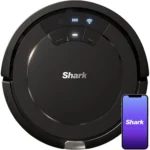Are you tired of tedious house cleaning tasks? Do you struggle to find the time to regularly clean your floors? Look no further than Robot Vacuum Cleaners. These innovative devices have been taking the home cleaning market by storm, promising convenience and efficiency. However, as with any product, there are pros and cons to consider before investing in one. In this article, we will dive into the advantages and disadvantages of owning a robot vacuum cleaner, helping you make an informed decision about whether this technology is right for your home.
Pros of Robot Vacuum Cleaners

When it comes to cleaning our homes, we often look for ways to make the process easier and more efficient. This is where robot vacuum cleaners come in. These innovative devices have taken the cleaning industry by storm, providing a wide range of benefits for homeowners. From convenience to advanced navigation technology, robot vacuum cleaners have quickly become a popular household item. Let’s take a closer look at some of the top pros of these intelligent cleaning machines. And if you’re interested in learning more about the different types of smart vacuums, check out our handheld vs. stick vacuums article.
1. Convenience
Convenience is perhaps the most significant advantage of robot vacuum cleaners, which has made them popular among working professionals and busy families. With 24/7 availability and easy scheduling options, these vacuum cleaners save a lot of time and effort for users.
Robot vacuums come with various features that add to their convenience, including automatic charging and resuming of cleaning sessions. Remote controls and smartphone applications allow users to control and schedule cleaning preferences with ease. Additionally, some robot vacuum cleaners integrate with digital assistants such as Alexa and Google Home, allowing users to control cleaning with simple voice commands.
The low-profile design of most robot vacuum cleaners also makes them convenient for cleaning under furniture and hard-to-reach areas. Users can focus on other tasks while the robot cleans and finishes the job without supervision.
However, for pet owners, it is essential to choose a robot vacuum that is specifically designed for pet hair. Check out our article on the best smart vacuums for pet hair in 2021 to make sure you choose the right one for your furry friends.
The convenience of using robot vacuum cleaners has made them a popular choice among consumers, and manufacturers are continually improving the technology to add more features and improve functionality.
2. Time-saving
When it comes to keeping our homes clean, traditional vacuum cleaners can be time-consuming and tiring to use. However, using robot vacuum cleaners offers a solution to this problem. The time-saving aspect is one of the greatest advantages of robot vacuum cleaners.
With traditional vacuum cleaners, you need to spend time and energy moving around the house to clean each room. Robot vacuum cleaners, on the other hand, move around the house and clean every corner, using intelligent sensors to detect any obstacles on the way. The amount of time you spend on vacuum cleaning is dramatically reduced, allowing you to focus on other tasks.
Let’s compare how much time we spend on traditional cleaning versus robot vacuum cleaning:
| Type of Cleaning | Time Spent |
|---|---|
| Traditional Vacuum Cleaning | 2 hours |
| Robot Vacuum Cleaning | 30 minutes |
As you can see, using robot vacuum cleaners is a great way to save time and energy. With this amount of time saved, you can now focus on other activities, such as spending time with your family, catching up on work, or pursuing hobbies.
However, it’s worth noting that not all robot vacuum cleaners are made equal. Some are better than others in terms of cleaning efficiency and smart navigation. Before choosing a robot vacuum cleaner, it’s important to read reviews and ratings to ensure you are making an informed choice. You can find helpful tips on selecting the right robot vacuum cleaner by clicking on the link to our “smart vacuum choosing tips” article.
It’s also worth mentioning that like all electronic devices, robot vacuum cleaners require maintenance. However, this is a small price to pay for the amount of time and effort you save on cleaning. You can find maintenance tips for robot vacuum cleaners in our article “smart vacuum cleaner maintenance tips”.
The time-saving aspect of robot vacuum cleaners makes them valuable tools for keeping our homes clean. By utilizing this technology, we can free up our time for more important tasks and activities.
3. Regular cleaning
Robot vacuum cleaners are designed to perform regular cleaning without much human intervention. They can be programmed to clean at a specific time and can navigate to every corner of the house. This feature ensures that your home remains clean and tidy at all times, with minimal effort on your part.
Regular cleaning is essential in maintaining a clean home, especially if family members have allergies since dirt and dust can aggravate their symptoms. Robot vacuums can perform daily cleaning, and some models can even perform multiple cleaning cycles. Their sensors, brushes, and suction power are designed to pick up smaller particles such as pet hair, dust mites, and other allergens that can trigger allergies.
Some robot vacuum models such as the Roomba i7+ are equipped with a self-emptying bin, allowing it to perform several cleaning cycles and empty itself automatically. This feature ensures that the vacuum is always ready to clean, even when you’re away from home.
Regular cleaning with robot vacuums can also help maintain the durability of your floors. Dirt and dust can scratch hardwood floors and damage carpet fibers, leading to the need for costly repairs. By using a robot vacuum, you can ensure that your floors remain clean without the risk of damage.
However, it’s important to note that not all robot vacuums are designed for the same surfaces, and some models may struggle on thicker carpets or uneven surfaces. Robot vacuums do require regular maintenance, such as emptying the dustbin, cleaning the brushes, and replacing filters. But with proper maintenance, regular cleaning with a robot vacuum can be incredibly effective in keeping your home clean and hygienic.
If you’re looking for a convenient and time-saving way to keep your home clean, then a robot vacuum is an excellent investment. To ensure that you choose the right model for your needs, check out our smart vacuum choosing tips. And for more information on maintaining your robot vacuum and prolonging its lifespan, check out our smart vacuum maintenance tips.
4. Multiple surface cleaning
Robot vacuum cleaners are an innovative invention that has made cleaning easier and more efficient. One of the biggest advantages of having a robot vacuum cleaner is “multiple surface cleaning.” These devices are equipped to clean different types of surfaces without causing damage.
The main reason for this is the different cleaning modes that robot vacuums offer. Whether you have carpet, hardwood floors, or tiles, a robot vacuum cleaner can be programmed to clean all surfaces equally. You can simply select the appropriate cleaning mode and the robot vacuum cleaner will take care of the rest.
Robot vacuum cleaners use different brushes to clean different surfaces like carpets and hard floors. The brushes are designed to ensure that dirt and dust are not left behind, which is especially important for allergy sufferers. If you want to clean a specific spot, most of these smart vacuums come with spot cleaning features as well.
Some robot vacuum cleaners have the capability to detect different surfaces and adjust their cleaning accordingly. They use advanced sensors and software to identify the type of flooring you have and then optimize their cleaning path for the best results. This is an example of the smart navigation feature that robot vacuum cleaners have.
It is worth mentioning that different surfaces require different cleaning methods. For instance, carpets need more suction power while hard floors need more brushes. By having the ability to clean multiple surfaces, robot vacuum cleaners are a great investment for homeowners who have different types of flooring in their homes.
Multiple surface cleaning is one of the most impressive features of robot vacuum cleaners. It saves homeowners time and energy while ensuring that their floors are thoroughly cleaned. It is also important to note that robot vacuum cleaners are eco-friendly and have a minimal environmental impact. If you’re looking to invest in a robot vacuum cleaner, make sure to choose one that offers multiple surface cleaning to get the most out of it.
**Internal Link:** To learn more about future smart vacuums, check out our future-smart-vacuums article.
5. Smart navigation
Robot vacuum cleaners come with smart navigation features that make them stand out from traditional vacuum cleaners. Smart navigation allows the robot vacuum cleaner to navigate its way around a room without bumping into furniture or objects.
One of the main features of smart navigation is the use of sensors. These sensors keep the robot vacuum cleaner from bumping into furniture and walls. They also help the robot vacuum cleaner to detect and avoid objects that may be on the floor, like toys, shoes or socks.
Most of the advanced robot vacuum cleaners come with mapping technology. This technology helps the robot vacuum cleaner to create a map of the room, which it then uses to move around and clean the floors. With mapping technology, the robot vacuum cleaner knows where it has already cleaned and where it needs to go next.
Another benefit of smart navigation is the ability to customize cleaning schedules. Users can set cleaning schedules for the robot vacuum cleaner so that it cleans at specific times, days or weeks. This feature works well for working professionals or busy families who don’t have time to clean their house regularly.
Smart navigation also improves the battery life of the robot vacuum cleaner. It enables the device to clean efficiently without using up its battery life too quickly. The robot vacuum cleaner will go back to its charging dock when its battery is low and resume cleaning once it’s fully charged.
Additionally, smart navigation features allow for easy maintenance of the robot vacuum cleaner. The robot vacuum cleaner can send notifications to the user’s phone when it needs maintenance or repair. Users can also check the status of the device, such as battery life or cleaning schedule, from their smartphone.
However, some critics argue that robots generate environmental costs resembling real vacuum cleaners in power, replaceable filters, noise or recycling. You may be interested in reading more about the environmental impact of smart vacuum cleaners.
Smart navigation is one of the significant advantages of robot vacuum cleaners. It saves time, and users have complete control over cleaning schedules. The customizable cleaning schedules, the effortless maintenance, and improved battery life make these devices much more practical and convenient than traditional vacuum cleaners.
Cons of Robot Vacuum Cleaners
It’s true that robot vacuum cleaners offer tremendous benefits and convenience, but they are not perfect. Like any technology, they have their drawbacks. In this section, we’ll explore the downsides of using robot vacuum cleaners, including their cost, limitations, and added maintenance expenses. It’s important to consider these factors before investing in a robot vacuum cleaner.
1. Expensive
One of the primary disadvantages of robot vacuum cleaners is their expensive price tag. While traditional vacuum cleaners can be purchased for as little as under $100, a quality robot vacuum cleaner can cost several hundred dollars, with high-end models costing even more.
However, it’s essential to consider the long-term cost-effectiveness of robot vacuum cleaners. They may seem expensive at first, but they can save you time and effort in the long run, leading to a better quality of life.
Moreover, robot vacuum cleaners are a relatively new technology, and advancement in technology always comes with a higher cost. But as they become more popular and mainstream in the market, the price of robot vacuum cleaners is likely to decrease.
Another factor to consider when the cost of robot vacuum cleaners is the potential maintenance requirements in the future. For example, the battery might need to be replaced after a certain period or some specialized parts, such as the dustbin or brush. You’ll also need to factor in the cost of maintenance and replacement parts into the overall cost.
It cannot be denied that robot vacuum cleaners are a significant investment to make for your home, but they provide value in the long run. If you’re considering purchasing one, be sure to do your research and read reviews before making a selection.
Additionally, with the rise of AI and smart vacuum cleaners, the cost of advanced robot vacuum cleaners is expected to rise. However, with new features like charging battery management, smart vacuum cleaners will help keep the cost of ownership down while improving performance.
While the cost of robot vacuum cleaners may seem high at first, it’s important to consider the long-term cost-effectiveness, future advancements, and maintenance requirements to make the right decision for your home.
| Pros | Cons |
|---|---|
| Convenience | Expensive |
| Time-saving | Not suitable for all surfaces |
| Regular cleaning | Limited cleaning capability |
| Multiple surface cleaning | Additional maintenance cost |
| Smart navigation |
2. Not suitable for all surfaces
Robot vacuum cleaners have become increasingly popular in recent years due to their convenience and efficiency in cleaning various surfaces. However, one of the cons of these devices is that they are not suitable for all surfaces. It is important to consider this limitation before investing in a robot vacuum cleaner.
Surfaces where Robot Vacuum Cleaners Work Well
Robot vacuum cleaners work best on hard and flat surfaces like tiles, hardwood floors, and laminate flooring. They are also suitable for low-pile carpets and rugs. Most robot vacuum cleaners have the ability to detect carpets and adjust their cleaning settings accordingly. This feature helps prevent damage to the carpet and allows for efficient cleaning.
Surfaces where Robot Vacuum Cleaners may not Work
Unfortunately, robot vacuum cleaners may not be suitable for high-pile carpets or shag rugs as they may get stuck or not provide efficient cleaning. These types of surfaces require a more powerful vacuum to adequately clean. Additionally, robot vacuum cleaners need to navigate around obstacles and may not be able to clean tight corners or spots that require manual cleaning.
Alternative Options for Cleaning Unsuitable Surfaces
If you have surfaces that are not suitable for robot vacuum cleaners, there are alternative cleaning options available. For example, high-pile carpets and shag rugs can be cleaned with a more powerful vacuum or a carpet cleaner. Tight corners and hard-to-reach spots may require manual cleaning with a handheld vacuum or a traditional broom and dustpan.
It is important to assess the surfaces in your home before investing in a robot vacuum cleaner. If most of your floors are hard and flat surfaces or low-pile carpets, a robot vacuum cleaner may be an excellent investment. However, if you have a lot of high-pile carpets or areas that require manual cleaning, it may be best to consider alternative cleaning options.
While robot vacuum cleaners are a convenient and efficient way to clean your home, they are not suitable for all surfaces. It is important to consider the limitations of these devices and assess the surfaces in your home before deciding to invest in one.
3. Limited cleaning capability
When it comes to cleaning capability, robot vacuum cleaners have their limitations. While they can effectively pick up dirt and debris on hard surfaces like hardwood floors and tiles, they may struggle on carpets or rugs. This limitation is due to their suction power and brush mechanism, which might not be strong enough to fully clean carpets and rugs.
Robot vacuum cleaners have difficulty cleaning tight spaces and corners because of their size and shape. It can be challenging for them to reach areas that are inaccessible or difficult to clean, such as under furniture or along edges.
Another limitation of robot vacuums is their smaller dustbin size, which means they need to be emptied more frequently than traditional vacuum cleaners. This can be especially inconvenient for pet owners or households with shedding animals, as the vacuum may need to be emptied multiple times during a single cleaning session.
Robot vacuum cleaners may not be equipped to handle tough stains or spills. Although some models have wet mopping capabilities, they may not be able to effectively clean up larger spills or stains, requiring additional manual cleaning efforts.
Table: Limitations of Robot Vacuum Cleaners
| Limitations | Description |
| Cleaning Carpeted Surfaces | Robot vacuums may struggle to effectively clean carpets and rugs. |
| Tight Spaces and Corners | Robot vacuums may find it difficult to clean areas that are inaccessible or difficult to reach. |
| Small Dustbin Size | Robot vacuums need to be emptied more frequently due to their smaller dustbin size. |
| Limited Stain and Spill Cleaning | Robot vacuums may not be equipped to handle tough stains or spills, requiring additional manual cleaning efforts. |
While robot vacuum cleaners offer a convenient and easy way to keep your floors clean, their limitations need to be considered before making a purchase. It’s important to evaluate your cleaning needs and assess whether a robot vacuum cleaner is the best choice for your home.
4. Additional maintenance cost
One important factor to consider when making a decision about purchasing a robot vacuum cleaner is the additional maintenance cost that comes with it. While these automated cleaners require less physical effort from their owners, they do still require upkeep to function optimally.
Here are some potential maintenance costs to keep in mind:
- Replacement Parts: Just like traditional vacuums, robot vacuum cleaners also have parts that need to be replaced from time to time. For example, the brushes and filters will need to be replaced periodically to ensure the best possible cleaning performance.
- Battery Replacement: Robot vacuum cleaners typically use rechargeable batteries to power their cleaning cycles. Over time, these batteries will need to be replaced as they lose their capacity to hold a charge.
- Cleaning: While robot vacuum cleaners do the bulk of the cleaning themselves, they still require occasional cleaning and maintenance of their own. This includes things like emptying the dustbin and cleaning the brushes to prevent dirt and debris build-up.
- Repairs: If your robot vacuum cleaner stops working or starts malfunctioning, you may need to pay for repairs or replacement parts. Depending on the complexity of the repair, this can become quite costly.
While a robot vacuum cleaner can be a convenient and time-saving addition to your cleaning routine, it is important to keep in mind the potential additional maintenance costs involved. By staying on top of regular cleaning and occasional repairs, however, you can ensure that your robot vacuum cleaner continues to function well and provide you with a clean home.
Conclusion
After weighing the pros and cons of robot vacuum cleaners, it’s clear that they offer a plethora of benefits that make cleaning more convenient, less time-consuming, and less labor-intensive. With their smart navigation and multiple surface cleaning capabilities, they can become a helpful and reliable addition to any home.
However, it’s also important to consider the drawbacks. Robot vacuum cleaners can be expensive, and they may not work on all surfaces. Additionally, they have limited cleaning capability, meaning that they may not be able to fully replace traditional cleaning methods altogether. It’s also worth noting that they may require additional maintenance costs, such as replacing the batteries or cleaning their brushes.
Overall, whether or not a robot vacuum cleaner is right for you depends on your individual needs and budget. If you’re someone who values convenience and efficiency and is willing to make an investment, they could be an excellent option. However, if you have specific cleaning needs or a smaller budget, a traditional vacuum cleaner may be a better fit. The decision ultimately comes down to personal preference and priorities.
Frequently Asked Questions
1. Are robot vacuum cleaners worth the cost?
It depends on your budget and cleaning needs. While they may be more expensive than traditional vacuums, they offer convenience and time-saving benefits.
2. Can robot vacuum cleaners replace traditional vacuums?
Robot vacuums are designed to supplement regular cleaning, not replace it entirely. They are particularly useful for quick, everyday cleans, but traditional vacuums are still necessary for deep cleaning.
3. How do robot vacuum cleaners navigate around a room?
The majority of robot vacuums use sensors and cameras to map out a room and navigate around obstacles. Some models even offer advanced navigation capabilities, including room mapping and virtual boundaries.
4. Can robot vacuum cleaners clean multiple surfaces?
Yes, most robot vacuums can clean multiple surfaces, including carpets, hardwood floors, and tiles. However, it’s important to check the specifications of each model to ensure it’s suitable for the surfaces in your home.
5. Do robot vacuum cleaners require a lot of maintenance?
Robot vacuum cleaners require regular maintenance, including emptying the dustbin and cleaning the brushes and filters. However, this typically takes only a few minutes and is less labor-intensive than traditional vacuum maintenance.
6. Can robot vacuum cleaners clean corners and edges?
Most robot vacuum cleaners have brushes and sensors designed to clean corners and edges effectively. However, some models may struggle with tight spaces or heavily soiled areas.
7. How long do robot vacuum cleaners last?
The lifespan of a robot vacuum cleaner varies depending on the quality of the device and the frequency of use. However, a well-maintained robot vacuum can last for up to 5 years.
8. How loud are robot vacuum cleaners?
Robot vacuum cleaners are typically quieter than traditional vacuums. However, the noise level varies depending on the model, with some being louder than others.
9. Can I control my robot vacuum cleaner with a mobile app?
Many robot vacuum cleaners come with mobile apps that allow you to control the device remotely. This feature can provide added convenience and flexibility.
10. How do I ensure my robot vacuum cleaner stays charged?
Most robot vacuum cleaners come with a charging dock that the device will return to once the battery runs low. It’s important to ensure the charging dock is placed in a convenient location and that the device is fully charged before each use.








